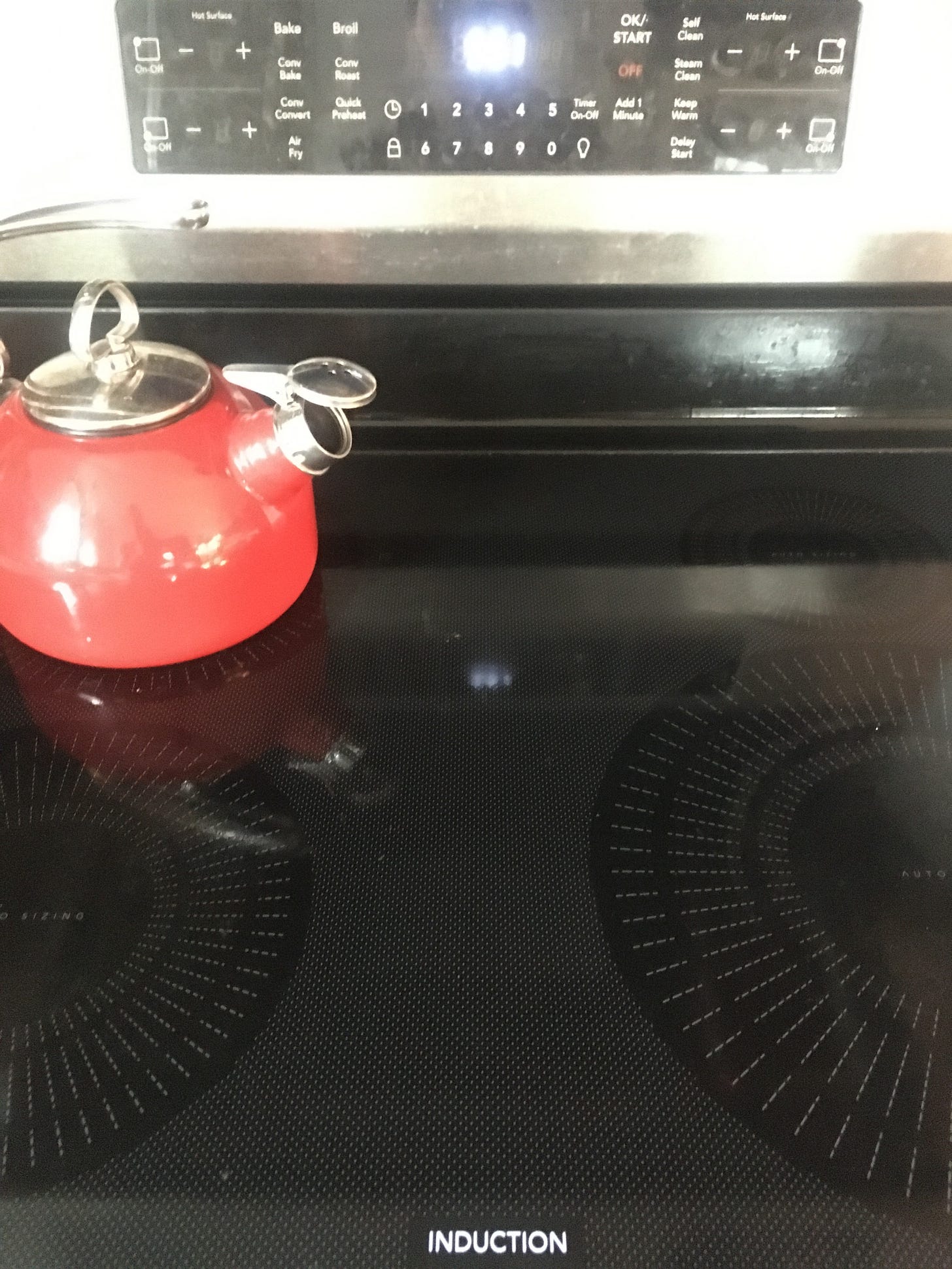This is a love letter to my stove, but let’s back up for some context:
Now that we measure time in pandemics, I’ve been on a mission to get my life off fossil fuels since mid-pandemic. In early 2021, I ripped any perfectly good propane-powered systems out of the RV that came for free with a little plot of land I bought in the Catskills. A year later, when sufficiently fed up with the rising costs of natural gas in my own home in Sleepy Hollow, NY, I began in earnest to cut the pipes here too. The map of my mission to fully electrify comes from an article called “Electrify Everything! A Practical Guide to Ditching Your Gas Meter” by Nate Adams in Greentechmedia.com, May 8, 2018, which I printed out, underlined and carry around for reference.
Adams lays out a clear action agenda for replacing gas systems in your home and life with electric and why that might matter. Ironically, I’m willing to pay plenty in order to save costs (and the trouble of recurring bills) in the future, so I’ll admit none of this process is cheap, but I’m here to report it’s very possible for a frugal person of middling income like myself, and a single mom no less, to get this done with resourceful workarounds. And it’s worth it, both financially longterm, and of course for the earth.
But back to my glorious stove, basically step one of Adams’ plan. Many might be onboard for cutting off gas in general, but when it comes to the concept of losing their gas cooktop, they are less willing. Induction stoves have been around for a while but haven’t really caught on yet.
“If your water is hot and your beer is cold you really don’t care how it got that way. You have no emotional connection to the technologies. There is one thing that you probably have an emotional connection to: gas cooking,” Adams writes. “Electrifying everything requires removing the gas meter, and that means getting rid of the gas stove. This is by far the most difficult hurdle.”
I like food, but I wouldn’t say I have the time or expendable cash to be a dedicated foodie, so maybe I don’t have the same hesitancy surrounding this shift as many might. Case in point: in my day job in local government we get many calls from constituents asking for help. Among them recently was a pair of stressed congregants of the large Durga Temple under construction in White Plains that will serve much of Westchester’s Hindu community. They cut the gas lines in order to build, with the understanding that they could be reconnected when ready for the sake of their dishwashing and cooking needs. The congregants wrote for our assistance now that Con Edison wasn’t willing to reconnect them. In light of the moratorium for new gas lines in Westchester County, and recent studies that are revealing how unhealthy cooking with gas (and carbon monoxide) might be—and the U.S. Consumer Product Safety Commission threatening possible regulation, I injected my own bit into the exchange: basically saying, yes we’ll try to help you convince Con Ed, but should that not work out, can I boast a bit about how great my induction stove is and how cool it might be for you and future generations to have a state-of-the-art and sustainable temple.
The men from the temple had some questions about how this might work in light of their desire to cook many public feasts in this space, which they thought only gas could accommodate, but they quickly came to believe—for both cost and efficiency—that going induction would be the preferred approach. I’m so proud to have effectively created a whole congregation of converts to the church of electric! Perhaps I can continue this mission here in this newsletter, reader by reader.
While induction can be pricey, I found a used stove on Facebook Marketplace that was like new except with some minor nicks dating back to the showroom on the glass surface that don’t affect anything. This Frigidaire model new at Home Depot goes for $1,364, while I got mine for $350 with a pick up truck and an hour drive to Long Island (which is definitely a sacrifice, but worth it). It also comes with air fryer and convection so now I can partake of that fun too. An induction stove requires a dedicated 220-volt outlet protected by 40-50 amp breakers. I got quotes from a few electricians to convert my outlet for around $200, plus the cost of cord which of course is bananas these days. I ended up just buying my own materials and out-boyfriending the labor (cord, breaker and outlet for $140). You don’t need to do anything with the gas at this stage except shut the valve at the back of the appliance and remove the old stove (which, by the way, I sold on FB Marketplace for $50 and thus didn’t have to take to the curb). Total project cost including stove and minus old stove proceeds, $440.
To prepare for this upheaval in your kitchen, you may also need new (or old!) cookware. Induction works via electromagnetism, the key word here being magnet. If a magnet sticks to your pot, it will work! Luckily, I already happened to have a set of stainless steel cookware with the induction label on the bottom. You can use stainless, blue, carbon steel, cast iron, not aluminum. Enamel or ceramic-coated iron also works. I do have yet to replace my griddle pan so have been making frying pan pancakes in the meantime.
I was in love with the smooth black glass surface of my stove on day one. No scouring around difficult burners. No potential of killing off my kids in their sleep should I accidentally leave a burner open and unlit. Gained a whole new section of counter space when I’m not cooking. Lost a layer of billing folded into my Con Ed statement (just baseline alone, there was about a $23 standing fee to have gas before I used any each month, so that’s gone now too).
I happily do magic trick demos for anyone who comes by. Within seconds of putting room temperature water in a pot to boil, it’s rolling. There is no agony of watching the pot boil anymore, that metaphor is dead to me. It just boils, faster than you can imagine. In fact, sometimes I get into trouble as I leave and go do a thing and come back to find the water long ago evaporated on the stove I forgot to check. So be careful about that; it can work too well! Lower settings are your friend. Besides boiling water, you would never really want your stove on high I’m learning; it would burn anything in an instant. The rest is typical stove business with more delicate controls than just bigger or smaller flame of gas.
More about induction: it’s not the kind of smooth top that heats up red. The amazing thing about induction that makes it so efficient (85% efficiency vs. 70% with standard electric or 30-40% with gas) is the heat conducts directly to the pot. Copper coils under the surface are generating a current that jumps to the cookware evenly, not the stove.
NYSERDA website has a whole helpful section on cooking with induction, including more on how the technology works and an eager chef doing demos:
I thought I might miss the romantic hiss and enticing blue flame of cooking with gas, but I don’t—I have a wood stove upstate for that. Adams suggests trying out a training wheel version and getting a plug-in portable cooktop for a bit if you’re feeling sentimental about the shift.
He mentions a skeptical client, Lilli. “She was adamantly against induction. We asked her to make the decision based on experience, not emotion, and she agreed to buy an induction hot plate. She completely reversed her position. Now she can’t wait to get to get rid of her gas stove, which off their indoor air quality monitor with the combustion gases it releases into the kitchen. She found induction to be very controllable (you can even do sous vide on it) and loves that her hot plate turns itself off automatically. We were stunned by her reversal! Perhaps you might do the same.”
Now years after this 2018 article, knee-jerk politics comes into play with talk of potential gas bans, and you have a whole culture war playing out in this recent article in Bloomberg.com that has none other than the Viking stove company’s founder and a former executive raving about the superiority of induction, verses:
Republican Representative Ronny Jackson of Texas dared someone to pry his stove from his “cold dead hands,” while fellow Republican Representative Jim Jordan of Ohio found traction with the pithier “God. Guns. Gas stoves.”
Shall we say it’s getting heated? But not my actual cooktop, mind you, just my pot and the food in it. And I’m happy to show anyone how fast.
Appointments for the magic show water boil on request.





Good to know!
Induction buddies!